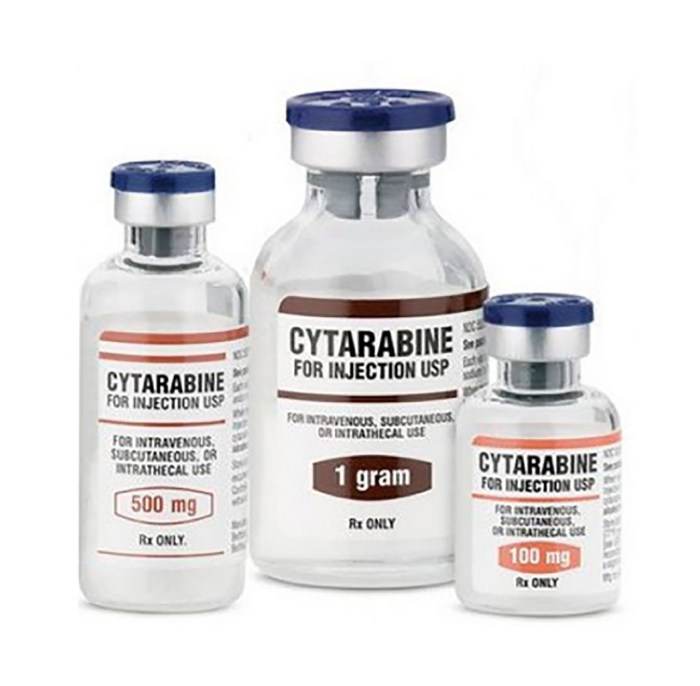Cytarabine, a potent chemotherapeutic agent, plays a crucial role in the treatment of various cancers. It acts by inhibiting DNA synthesis, effectively halting the growth and proliferation of cancerous cells. Cytarabine is widely used in the treatment of leukemias, particularly acute myeloid leukemia (AML), and is often administered in combination with other chemotherapy drugs.
The effectiveness of cytarabine is attributed to its ability to interfere with the synthesis of DNA, a vital component of cell division. This mechanism of action makes it a valuable tool in combating rapidly dividing cancer cells. Cytarabine is administered intravenously, and its pharmacokinetic properties are influenced by factors such as age, renal function, and drug interactions.
Patient Perspectives and Quality of Life

Cytarabine treatment, while effective in combating certain cancers, can significantly impact patients’ quality of life. Understanding the multifaceted challenges patients face and exploring strategies to improve their well-being is crucial. This section delves into the physical, emotional, and social aspects of cytarabine treatment, highlighting patient perspectives and strategies for enhancing their quality of life.
Impact on Physical Health, Cytarabine
Cytarabine’s effects on physical health are a primary concern for patients. Common side effects include:
- Myelosuppression: Cytarabine suppresses bone marrow function, leading to a decrease in blood cell production. This can result in anemia (low red blood cell count), neutropenia (low white blood cell count), and thrombocytopenia (low platelet count), increasing the risk of infections and bleeding.
- Gastrointestinal Issues: Nausea, vomiting, and diarrhea are common side effects. These can lead to dehydration, malnutrition, and discomfort.
- Neurotoxicity: Cytarabine can affect the nervous system, causing symptoms such as confusion, memory problems, and seizures. In severe cases, it can lead to cerebellar dysfunction.
These physical challenges can significantly impact patients’ daily lives, affecting their ability to work, perform daily tasks, and maintain their independence.
Emotional Well-being
The physical and emotional toll of cytarabine treatment can lead to significant psychological distress. Patients may experience:
- Anxiety and Depression: The fear of disease progression, side effects, and uncertainty about the future can contribute to anxiety and depression.
- Fatigue and Weakness: The physical side effects of cytarabine can lead to fatigue and weakness, impacting energy levels and motivation.
- Body Image Concerns: Hair loss, weight changes, and other physical changes associated with treatment can affect body image and self-esteem.
These emotional challenges can further complicate the patient’s experience, impacting their relationships and overall well-being.
Social Impact
Cytarabine treatment can also have a significant impact on patients’ social lives.
- Social Isolation: The physical limitations and emotional distress associated with treatment can lead to social isolation. Patients may find it difficult to participate in social activities and maintain relationships.
- Financial Strain: Treatment costs, travel expenses, and lost wages can create significant financial strain for patients and their families.
- Role Strain: Patients may struggle to balance their treatment needs with their responsibilities at work, home, and in their personal lives.
These social challenges can further exacerbate the difficulties faced by patients, impacting their overall quality of life.
Strategies for Improving Quality of Life
Several strategies can be implemented to improve the quality of life of patients undergoing cytarabine therapy. These include:
- Supportive Care: Providing supportive care, such as blood transfusions, antibiotics, and anti-nausea medications, can help manage side effects and improve physical well-being.
- Symptom Management: Effective symptom management is crucial for enhancing quality of life. This includes addressing pain, fatigue, nausea, and other common side effects.
- Psychological Support: Providing psychological support through counseling, therapy, and support groups can help patients cope with the emotional challenges of treatment.
- Social Support: Encouraging social interaction and providing access to support services can help reduce social isolation and improve overall well-being.
- Financial Assistance: Providing financial assistance, such as grants or programs, can help alleviate financial strain and reduce stress.
By implementing these strategies, healthcare providers can help patients manage the challenges of cytarabine treatment and improve their quality of life.
Patient Perspectives
“The physical side effects were tough, but the emotional toll was even harder. It felt like I was losing control of my life.” – A patient undergoing cytarabine treatment.
“I was so tired all the time, I couldn’t even do the things I used to enjoy. It was hard to stay positive.” – Another patient undergoing cytarabine treatment.
These quotes highlight the significant impact cytarabine treatment can have on patients’ lives. It’s essential to recognize the individual experiences of patients and provide them with the necessary support to navigate the challenges of treatment.
Historical Perspective and Evolution of Cytarabine

Cytarabine, a potent anti-cancer drug, has a rich history spanning over half a century, marked by significant milestones in its discovery, development, and clinical application. This journey reflects the continuous evolution of our understanding of cancer biology and the relentless pursuit of effective treatments.
Early Discovery and Preclinical Studies
Cytarabine’s journey began in the 1950s with its synthesis by scientists at the Upjohn Company. Initial preclinical studies revealed its potent anti-cancer activity, particularly against leukemia cells. These studies laid the groundwork for its clinical investigation as a potential therapeutic agent.
Initial Clinical Trials and Approval
In the early 1960s, cytarabine entered clinical trials, initially focusing on acute leukemia. Early results demonstrated its efficacy in inducing remission in a significant proportion of patients. This success led to its approval by the Food and Drug Administration (FDA) in 1969 for the treatment of acute myelogenous leukemia (AML).
Refinement of Dosage and Administration
Following its initial approval, extensive research focused on optimizing cytarabine’s dosage and administration to maximize its efficacy and minimize side effects. Studies explored various routes of administration, including intravenous, intrathecal, and continuous infusion. These efforts led to the development of standardized protocols for cytarabine administration, enhancing its therapeutic value.
Evolution of Understanding Cytarabine’s Mechanism of Action
Initially, cytarabine’s mechanism of action was understood as an inhibitor of DNA synthesis. However, subsequent research unveiled a more complex interplay. Cytarabine’s primary mechanism involves its incorporation into DNA, disrupting the normal DNA replication process, leading to cell death.
Expansion of Therapeutic Applications
Over time, cytarabine’s therapeutic applications expanded beyond AML. It found efficacy in treating other hematological malignancies, including acute lymphoblastic leukemia (ALL), chronic myelogenous leukemia (CML), and lymphoma. Its use in combination therapies with other anti-cancer drugs further enhanced its therapeutic potential.
Continued Research and Development
Despite its widespread use, research on cytarabine continues. Scientists are exploring novel drug formulations, combination therapies, and targeted approaches to further enhance its efficacy and minimize its side effects. The development of cytarabine-based liposomal formulations has improved its bioavailability and reduced its toxicity, demonstrating the ongoing pursuit of better treatment options.
Cytarabine stands as a testament to the advancements in cancer treatment, offering a potent weapon against a range of hematologic malignancies. While its effectiveness is undeniable, careful monitoring and management of its potential side effects are crucial. Ongoing research continues to explore new avenues for maximizing its therapeutic potential and minimizing its toxicity, paving the way for even more effective and targeted therapies in the future.
Cytarabine is a chemotherapy drug used to treat various cancers, including leukemia and lymphoma. It works by interfering with the growth and division of cancer cells. Often, cytarabine is combined with other chemotherapy drugs, such as vincristine , which targets the microtubules responsible for cell division. The combination of these drugs can be highly effective in treating certain types of cancer, though side effects are common and can be severe.